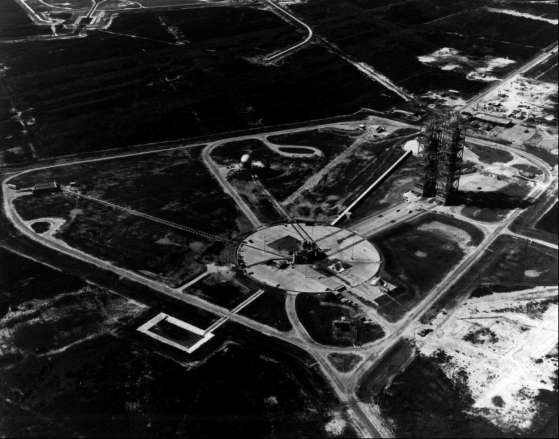
Labor Difficulties
Construction on several of LC-34's most prominent features including the service structure, launch pedestal, and umbilical tower was just getting under way when a serious labor dispute broke out at the Cape. On 5 August 1960, members of the electricians' union (International Brotherhood of Electrical Workers) informed a Corps of Engineers representative that, "It's too hot and ABMA is making it hotter. . . We're going fishing."29 The Launch Operations Directorate had generated the heat earlier that morning when some of its personnel unloaded a dozen firing consoles at the launch control center. The incident touched off four months of conflict between LOD and labor unions at the Cape, and eventually received the attention of Congress and the Secretary of Labor.
Involved were jurisdictional issues between unions, as well as the role of labor unions in research and development work. During the late 1950s, the building trades unions had achieved jurisdiction over a large share of the construction of ground support equipment for missiles. They feared loss of such jobs to the aircraft industry union. LOD officials believed that the building trades unions had won a number of concessions at the Cape because the Air Force normally yielded to labor demands. While the urgency of military programs made the Air Force position understandable, Debus refused to take the same course.* LOD articulated its philosophy in a 6 September presentation to General Davis, Air Force Missile Test Center Commander:
All ground equipment including measuring, launch controls, plumbing, instrumentation which are directly connected to the missile are a very integral part of the missile system. In the early phase of any program, the missile constitutes a flying laboratory for the purpose of gathering data and testing feasibility on design concepts, operational techniques. . . Thus the ground equipment is just as important to the success of the mission as is the actual flight of the missile. . . and must come under the direct control, from installation to final use, of the LOD missile people. All our firings will be R&D in nature, not operational prototypes.30
General Davis was impressed with the LOD arguments, but not so the unions. When LOD personnel returned to the launch control center on 10 October to install more panels, 47 electricians walked out again. Ten days earlier, 27 ironworkers had left work on the service structure complaining of excessive supervision; on 4 October, 17 carpenters stopped work in a jurisdictional dispute with electricians over the installation of static ground lines.31
These walkouts were brief and contractors lost only 800 man-days from August to November. Then on 14 November LOD resumed its activities at LC-34, with civil service personnel installing cables and consoles. When the electricians struck again, LOD initiated injunction proceedings. The other trade unions retaliated with a mass walkout at the Cape. By Thanksgiving 650 union members were on strike. With the problem attracting national attention, Secretary of Labor James P. Mitchell intervened. His appointment of a fact-finding committee placated the unions and work resumed 28 November. The committee's findings, released after the New Year, included recommendations that LOD improve its communications with the unions and that both sides re-examine the controversial interface points (between rocket and ground support equipment). While the basic issue remained and work stoppages continued, relations never again reached the low ebb of November 1960.32

LC-34 soon after its dedication. Looking north, the pad is in the center; The service structure has been removed along its parallel tracks to the parking position. The control center (blockhouse) is on the near side and left of the service structure. In the background, land is being cleared for LC-37.

LC-34 looking southwest. LC-20 is in the background. The white rectangle in the foreground is the skimming pond. The RP-1 facility is at the extreme left.
Work moved ahead rapidly on LC-34's major structures in early 1961. By February the inverted U shape of the service structure's rigid box truss frame was clearly recognizable. At the pad, four reinforced concrete columns, 7 meters high and more than 2 meters thick, stood at the corners of the 13-meter-square launch pedestal. Nearby rose the steel frame of the abbreviated umbilical tower. The walls of the 7 x 7 x 8-meter base would incorporate blowout panels to reduce structural damage from a pad explosion.
At its formal dedication 5 June 1961, LC-34 represented the largest launch facility in the free world. Although complexes 37 and 39 would soon overshadow it, LC-34 was destined to play an important and tragic role in the Apollo history. Its inaugural would come in four months with the first Saturn I launch as the United States tried to recover lost ground in the space race.
* Gen. Donald Yates contends that Air Force policy was a better approach to labor relations, Non-union contractors did work at the Cape, but the Air Force never placed a non union contractor on the same job with a union contractor. Furthermore, Yates felt that LOD leaders tended to challenge union labor with their new rules.
29. R. P. Dodd to C. C. Parker, 8 Aug. 1960.
30. Debus to Wernher von Braun, "Labor Situation," 21 Sept. 1960.
32. Ibid., pp. 30-35; DDJ, 15 and 28 Nov., 5 and 22 Dec. 1960.
| Next |